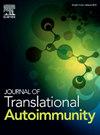基于剪接的生物标志物为复发缓解型多发性硬化症定义了一个强大的多基因分类器
IF 3.6
Q2 IMMUNOLOGY
引用次数: 0
摘要
选择性剪接(AS)被认为是多发性硬化症(MS)的关键机制。我们旨在构建并验证一个基于多变量as的分类器(MS- splicing Score, MS- ss),用于区分复发-缓解型MS (RRMS)患者和健康对照。方法根据功能和文献证据选择3个AS事件(IFNAR2外显子8跳变,NFAT5外显子2跳变,PRKCA外显子3 *包涵)。通过荧光竞争RT-PCR对来自两个独立队列(意大利:37个RRMS, 50个对照;美国:29个RRMS, 20个对照)的外周血RNA中的同种异构体进行定量。采用logistic回归模型推导MS-SS,并进行ROC分析。结果MS-SS将两组RRMS患者与对照组区分开来(意大利:p = 0.00083, AUC = 0.71, 95% CI = 0.59 ~ 0.82;美国:p = 0.00074, AUC = 0.77, 95% CI = 0.63 ~ 0.90)。在合并的数据集中,MS的评分仍然显著提高(p = 5.9 × 10−6,AUC = 0.72, 95% CI = 0.64-0.81),基于pca的改进提高了分类精度,AUC = 0.87 (95% CI = 0.81-0.94)。在最佳截止点(约登指数),该评分的灵敏度为80%,特异性为86%。使用逻辑学习机算法的基于规则的监督建模确定了可解释的剪接阈值,并在个体水平上实现了临床分类。我们的研究引入了一种新的、鲁棒的基于as的RRMS分类器,并提出了一种基于转录组的神经免疫学生物标志物开发策略。然而,每个队列中相对较小的样本量可能会限制这些发现的普遍性,因此需要更大规模的验证研究来确认该生物标志物的临床实用性。本文章由计算机程序翻译,如有差异,请以英文原文为准。
Splicing-based biomarkers define a robust multigene classifier for relapsing-remitting multiple sclerosis
Background
Alternative splicing (AS) is recognized as a key mechanism in multiple sclerosis (MS). We aimed to construct and validate a multivariate AS-based classifier (MS-Splicing Score, MS-SS) for the discrimination of relapsing-remitting MS (RRMS) patients from healthy controls.
Methods
Three AS events (IFNAR2 exon-8 skipping, NFAT5 exon-2 skipping, PRKCA exon-3∗ inclusion) were selected based on functional and literature evidence. Isoforms were quantified via fluorescent-competitive RT-PCR in peripheral blood RNA from two independent cohorts (Italy: 37 RRMS, 50 controls; USA: 29 RRMS, 20 controls). A logistic regression model was trained to derive the MS-SS, followed by ROC analysis.
Results
The MS-SS distinguished RRMS patients from controls in both cohorts (Italy: p = 0.00083, AUC = 0.71, 95 %CI = 0.59–0.82; USA: p = 0.00074, AUC = 0.77, 95 %CI = 0.63–0.90). In the pooled dataset, the score remained significantly elevated in MS (p = 5.9 × 10−6, AUC = 0.72, 95 %CI = 0.64–0.81), and a PCA-based refinement improved classification accuracy, yielding an AUC = 0.87 (95 %CI = 0.81–0.94). At the optimal cutoff (Youden's index), the score achieved a sensitivity of 80 % and specificity of 86 %. Supervised rule-based modeling using a logic-learning machine algorithm identified interpretable splicing thresholds and enabled clinical classification at the individual level.
Conclusion
Our study introduces a novel, robust AS-based classifier for RRMS and proposes a strategy for transcriptome-based biomarker development in neuroimmunology. However, the relatively small sample sizes within each cohort may limit the generalizability of these findings, warranting larger validation studies to confirm the clinical utility of this biomarker.
求助全文
通过发布文献求助,成功后即可免费获取论文全文。
去求助
来源期刊

Journal of Translational Autoimmunity
Medicine-Immunology and Allergy
CiteScore
7.80
自引率
2.60%
发文量
33
审稿时长
55 days
 求助内容:
求助内容: 应助结果提醒方式:
应助结果提醒方式:


